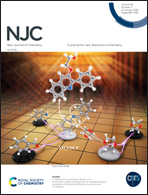Identification of fosaprepitant as a novel GSTP1 inhibitor through structure-based virtual screening, molecular dynamics simulation, and biological evaluation†
Abstract
Glutathione S-transferase P1 (GSTP1) is a promising target for cancer prevention and therapy, particularly because of its involvement in promoting cancer cell survival and resistance of tumors to therapeutic agents. In fact, multiple GSTP1 antagonists have been developed for cancer treatment; however, none of these inhibitors have been successfully used in clinical applications, probably because of the extreme complexity and high risk in translating molecules from novel drug discovery to clinical use. To overcome this obstacle, the strategy of drug repurposing was used in this study to identify potential GSTP1 inhibitors via structure-based virtual screening of compounds in the FDA database. Following this, fosaprepitant was identified as a potential GSTP1 inhibitor through a thorough assessment of docking scores, as well as interaction modes for further verification. Molecular docking and molecular dynamics simulations were performed to obtain a complex structure between the relatively stable inhibitor, fosaprepitant and GSTP1. Furthermore, based on the results of the microscale thermophoresis (MST) assay, fosaprepitant displayed good binding affinity with a Kd value of 62.5 ± 5.8 nM. Inhibitory assays showed that fosaprepitant was a potent inhibitor of GSTP1 with an average IC50 value of 278.7 ± 21.1 nM. Of note, fosaprepitant exhibited superior toxicity towards A549/DDP cells that overexpressed GSTP1 compared with the A549 cell line, which further supported its potential use as an effective GSTP1 inhibitor. In addition, the molecule showed significant ability to induce cell apoptosis in the A549/DDP cell line. Overall, these results provide new insights into the biological functions of specific small molecule inhibitors of GSTP1.



 Please wait while we load your content...
Please wait while we load your content...